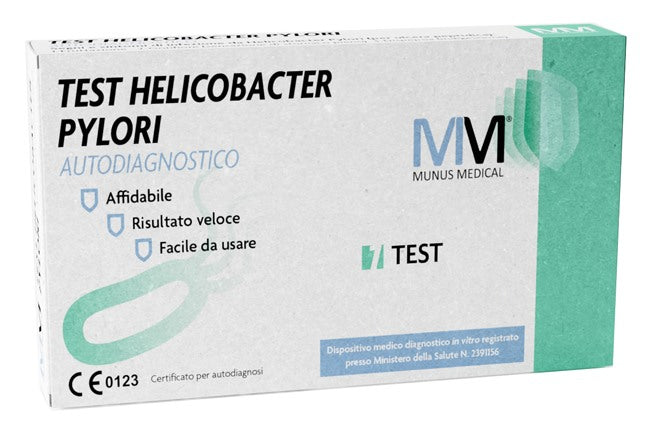MUNUS MEDICAL SELF-DIAGNOSTIC TEST HELICOBACTER PYLORI ANTIGEN MUNUS
Sold out
€9,90
Unit price
/
Unavailable
Tax included, shipping and discounts calculated at checkout.
MUNUS INTERNATIONAL | SKU:
986885097
Notify me when it's back in stock!
Write us your email, you will be notified when this product becomes available again!
MUNUS MEDICAL SELF-DIAGNOSTIC TEST HELICOBACTER PYLORI ANTIGEN MUNUS is backordered and will ship as soon as it is back in stock.
Shipping Costs and Times
Shipping Costs and Times
- Order fulfillment within 24 hours and delivery within the following 48/72 hours.
- Shipping cost: always free for orders over €49.90, otherwise it costs €4.99.
Payments
Payments
Payment information is processed securely. We do not store credit card information or have access to your credit card information.
Returns and Refunds
Returns and Refunds
You can return and receive a refund for the item within 30 days. See full policy here.

Do you need help?
Our customer service is here to help you!
- Contact us by phone, email or WhatsApp, from Monday to Friday, from 9:00 to 20:00 .
- For common questions, such as tracking your order or checking its fulfillment status, you can count on our artificial intelligence , available 24/7 .
We are always at your side to offer you fast and effective support!
Description
Description
MUNUS MEDICAL SELF-DIAGNOSTIC TEST HELICOBACTER PYLORI ANTIGEN MUNUS
MUNUS MEDICAL
HELICOBACTER PYLORI TEST
Description
Rapid chromatographic immunoassay for the qualitative detection of Helicobacter pylori antigens in human stool specimens. Uses antibodies specific for H. pylori antigens to selectively detect H. pylori antigens in human stool specimens.
In this test, the membrane is pre-coated with anti-H.pylori on the test line region. During the test, the sample reacts with the anti-H. pylori antibody-coated particle. The mixture migrates up the membrane by capillary action to react with the anti-H.pylori on the membrane and generate a colored line.
The presence of this colored line in the test region indicates a positive result, while its absence indicates a negative result. To serve as a procedural control, a colored line will always appear in the control line region indicating that an adequate volume of specimen has been added and membrane wicking has occurred.
How to use
Wash your hands with soap and rinse with water.
The stool sample should be collected in the stool collection paper or in clean collection containers. Use the stool collection paper, avoiding contamination of the sample by taking precautions so that the sample or the side of the paper containing the sample does not come into contact with contaminating objects, including toilet cleaners.
Unscrew the cap of the sample collection tube, then randomly insert the sample collection applicator into the stool sample at at least 3 different sites. Do not collect the stool sample. Screw and tighten the cap onto the sample collection tube, then shake the sample collection tube vigorously to mix the sample and extraction buffer for 2 minutes.
Allow the pouch to reach room temperature before opening. Remove the test cassette from the foil pouch and use it as soon as possible. Best results are obtained if the test is performed immediately after opening the foil pouch.
Open the cap of the sample collection tube and break off the tip. Invert the sample collection tube and transfer 2 full drops of the extracted sample into the sample well (S) of the test cassette, then start the timer. Avoid trapping air bubbles in the sample well (S).
Read results at 10 minutes. Do not read results after 20 minutes.
Interpretation of results
POSITIVE: Two lines appear, the test line (T) and the control line (C). The intensity of the color in the test line (T) region will vary depending on the concentration of Helicobacter pylori antigen present in the sample. Therefore, any shade of color in the test line (T) region should be considered positive. This result means that there is the presence of H. pylori antigen in the stool and you should consult a doctor.
NEGATIVE: A colored line appears in the control line area (C). No line appears in the test line area (T). This result means that H. pylori is not detectable in the stool.
INVALID: The control line (C) does not appear. Insufficient specimen volume or incorrect procedural techniques are the most likely reasons for the control line (C) not appearing. Review the procedure and repeat the test with a new test. If the problem persists, discontinue use of the test kit immediately and contact your local distributor.
Warnings
For in vitro diagnostic self-testing only. Do not use after the expiry date.
Do not eat, drink, or smoke in the area where specimens or kits are handled.
If the aluminum package is damaged or has been opened, do not use it.
Use a clean container to collect the fecal sample.
Strictly follow the indicated times.
Use the test only once. Do not disassemble or touch the test window of the test cassette.
Dispose of the used test according to local regulations.
Keep out of reach of children.
The test is to be used for the detection of H. pylori antigens in stool samples only. Neither the quantitative value nor the rate of increase in H. pylori antigen concentration can be determined by this qualitative test.
The test will only indicate the presence of Helicobacter pylori in the specimen and should not be used as the sole diagnostic criterion to determine whether Helicobacter pylori is a causative agent for peptic or duodenal ulcer.
Test results should be interpreted in conjunction with other clinical information available to the physician.
If the test result is negative and clinical symptoms persist, further testing using other clinical methods is recommended. A negative result never precludes the possibility of H. pylori infection.
Following some antibiotic treatments, the concentration of H. pylori antigens may decrease to a concentration below the minimum detection level of the test. Therefore, the diagnosis should be made with caution during antibiotic treatment.
Conservation
Store at room temperature or refrigerated (2-30 °C), avoiding areas of excessive humidity. Do not freeze.
The test is stable until the expiration date printed on the sealed pouch. The test cassette must remain in the sealed pouch until use. Do not use beyond the expiration date.
Validity with intact packaging: 24 months.
Format
The kit contains:
- test cassette;
- sample collection tube with extraction swab;
- package leaflet;
- paper for collecting feces.
Bibliography
1. Marshall, B. J., McGechie, D. B., Rogers, P. A. R., and Glancy, R. G. Pyloric Campylobacter infection and gastroduodenal disease. Med. J. Australia. (1985), 149: 439-444.
2. Soll, AH. Pathogenesis of peptic ulcer disease and implications for therapy. New England J. Med. (1990), 322: 909-916.
3. Hazell, SL, et al. Campylobacter pylori and gastritis I: detection of urease as a marker of bacterial colonization and gastritis. Amer. J. Gastroenterology. (1987), 82 (4): 292-296.
4. Cutler AF. Testing for Helicobacter pylori in clinical practice. Am j. Med. 1996;100:35S-41S.
5. Anand BS, Raed AK, Malaty HM, et al. Prevalence of Loe point of peptic ulcer disease in normal subjects with Helicobacter pylori infection. Am J Gastroenterol. 1996,91:1112-1115.
Cod. MM-IHP-602H
Rapid chromatographic immunoassay for the qualitative detection of Helicobacter pylori antigens in human stool specimens. Uses antibodies specific for H. pylori antigens to selectively detect H. pylori antigens in human stool specimens.
In this test, the membrane is pre-coated with anti-H.pylori on the test line region. During the test, the sample reacts with the anti-H. pylori antibody-coated particle. The mixture migrates up the membrane by capillary action to react with the anti-H.pylori on the membrane and generate a colored line.
The presence of this colored line in the test region indicates a positive result, while its absence indicates a negative result. To serve as a procedural control, a colored line will always appear in the control line region indicating that an adequate volume of specimen has been added and membrane wicking has occurred.
How to use
Wash your hands with soap and rinse with water.
The stool sample should be collected in the stool collection paper or in clean collection containers. Use the stool collection paper, avoiding contamination of the sample by taking precautions so that the sample or the side of the paper containing the sample does not come into contact with contaminating objects, including toilet cleaners.
Unscrew the cap of the sample collection tube, then randomly insert the sample collection applicator into the stool sample at at least 3 different sites. Do not collect the stool sample. Screw and tighten the cap onto the sample collection tube, then shake the sample collection tube vigorously to mix the sample and extraction buffer for 2 minutes.
Allow the pouch to reach room temperature before opening. Remove the test cassette from the foil pouch and use it as soon as possible. Best results are obtained if the test is performed immediately after opening the foil pouch.
Open the cap of the sample collection tube and break off the tip. Invert the sample collection tube and transfer 2 full drops of the extracted sample into the sample well (S) of the test cassette, then start the timer. Avoid trapping air bubbles in the sample well (S).
Read results at 10 minutes. Do not read results after 20 minutes.
Interpretation of results
POSITIVE: Two lines appear, the test line (T) and the control line (C). The intensity of the color in the test line (T) region will vary depending on the concentration of Helicobacter pylori antigen present in the sample. Therefore, any shade of color in the test line (T) region should be considered positive. This result means that there is the presence of H. pylori antigen in the stool and you should consult a doctor.
NEGATIVE: A colored line appears in the control line area (C). No line appears in the test line area (T). This result means that H. pylori is not detectable in the stool.
INVALID: The control line (C) does not appear. Insufficient specimen volume or incorrect procedural techniques are the most likely reasons for the control line (C) not appearing. Review the procedure and repeat the test with a new test. If the problem persists, discontinue use of the test kit immediately and contact your local distributor.
Warnings
For in vitro diagnostic self-testing only. Do not use after the expiry date.
Do not eat, drink, or smoke in the area where specimens or kits are handled.
If the aluminum package is damaged or has been opened, do not use it.
Use a clean container to collect the fecal sample.
Strictly follow the indicated times.
Use the test only once. Do not disassemble or touch the test window of the test cassette.
Dispose of the used test according to local regulations.
Keep out of reach of children.
The test is to be used for the detection of H. pylori antigens in stool samples only. Neither the quantitative value nor the rate of increase in H. pylori antigen concentration can be determined by this qualitative test.
The test will only indicate the presence of Helicobacter pylori in the specimen and should not be used as the sole diagnostic criterion to determine whether Helicobacter pylori is a causative agent for peptic or duodenal ulcer.
Test results should be interpreted in conjunction with other clinical information available to the physician.
If the test result is negative and clinical symptoms persist, further testing using other clinical methods is recommended. A negative result never precludes the possibility of H. pylori infection.
Following some antibiotic treatments, the concentration of H. pylori antigens may decrease to a concentration below the minimum detection level of the test. Therefore, the diagnosis should be made with caution during antibiotic treatment.
Conservation
Store at room temperature or refrigerated (2-30 °C), avoiding areas of excessive humidity. Do not freeze.
The test is stable until the expiration date printed on the sealed pouch. The test cassette must remain in the sealed pouch until use. Do not use beyond the expiration date.
Validity with intact packaging: 24 months.
Format
The kit contains:
- test cassette;
- sample collection tube with extraction swab;
- package leaflet;
- paper for collecting feces.
Bibliography
1. Marshall, B. J., McGechie, D. B., Rogers, P. A. R., and Glancy, R. G. Pyloric Campylobacter infection and gastroduodenal disease. Med. J. Australia. (1985), 149: 439-444.
2. Soll, AH. Pathogenesis of peptic ulcer disease and implications for therapy. New England J. Med. (1990), 322: 909-916.
3. Hazell, SL, et al. Campylobacter pylori and gastritis I: detection of urease as a marker of bacterial colonization and gastritis. Amer. J. Gastroenterology. (1987), 82 (4): 292-296.
4. Cutler AF. Testing for Helicobacter pylori in clinical practice. Am j. Med. 1996;100:35S-41S.
5. Anand BS, Raed AK, Malaty HM, et al. Prevalence of Loe point of peptic ulcer disease in normal subjects with Helicobacter pylori infection. Am J Gastroenterol. 1996,91:1112-1115.
Cod. MM-IHP-602H


